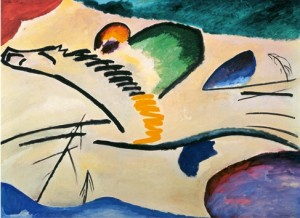Kandinsky’s inner necessity
Two years ago, I attended the big Kandinsky show at the Guggenheim and found a long line stretching out of the coiled building, all the way to the corner of Fifth Avenue and E. 88th St. The cheerful, amused couple behind me laughed and the husband, or boyfriend, said, “A good rain would shorten this line considerably.” I said, “Yeah, what happened to that forecast anyway?” I got a text from my son, Matt, about Michigan’s win and Ohio State’s loss—we’ll be chanting Go Blue again this afternoon during the first game of Michigan’s new season—and we texted until I walked into the building for another fifteen minute crawl through a serpentine line. It reminded me of Disney World’s switchback queues, and it was at least encouraging that a painting exhibition could still draw long lines of people willing to pay for a glimpse of it. Inside, I went up the elevator to the top of the spiral and wandered slowly down, against the flow of the crowd. For me, the work at the end of Kandinsky’s life was so lifeless as to be almost comical, and I wondered, knowing what was to come from the artist during the heat of his younger explorations, how such a visionary, inspired innovator could have shrunken into the safety of those geometric puzzles. He began his career talking about painting images at the bidding of an indeterminate inner necessity, a spiritual imperative, back when he referred to color as an instrument for creating visual music. Yet, as the years passed, he eventually became involved in Theosophy, as a way of systematizing the mystery of his intuitions, and it isn’t hard to imagine that Blavatsky’s odd theories about geometry took hold of his imagination. It isn’t that the later paintings fail, they just aren’t nearly as alive as his early work: you can see the way thought has taken charge, as the paintings become more and more visually predictable.
Strolling downward, I enjoyed the pull of gravity in the grade of that spiral mezzanine—Matthew Barney’s Cremaster show being the last time I’d been in the museum—as it drew me into work that went backward in time but upward in quality, until the line and color began to come apart and the storms of light and dark and the riot of brushwork dissolved the visual order of his paintings in a way that flooded me with sensations and flashes of buried seasonal memories, complex mixtures of emotion and visual perception. I remembered the two oils of his you can see briefly at the Chicago Art Institute in Ferris Bueller’s Day Off, when Ferris and his fellow truants wander about that great museum. A pair of early Kandinsky oils appear for a second, at most, backed by minor-key, oceanic music, so beautiful and haunting the whole thing makes you want to rewind and pause, forgetting about the rest of what happens in the story. And now, at the Guggenheim, like Ferris, I came upon two paintings, side by side, that had an equal evocative power, from his early years: seemingly windswept inscapes with variations of green and blue unlike those hues in any other painting I’ve ever seen. To create those colors in and of themselves was an achievement, but they offered more than a visual sensation, evoking an entire life, an unfinished world, apprehended through the eyes and the heart. Kandinsky transplanted that thirsty heart of his into those paintings, and I imagined him full of a joy only a painter knows, watching as something intangible, ineffable, slowly and seemingly on its own becomes visible for the first time—those colors revealing themselves as he painted them. That was the inner necessity he spoke of, back when he was doing work he couldn’t explain away.
But the most surprising moment in the entire tour was when I wandered outside the whorl of the central ramp and chanced upon one of the side galleries, on the third level I think, where the curator had assembled Kandinsky’s work on paper. If only he had quit painting in oil after those early years and switched entirely to paper. This geometric work was full of life, having a long, private and extremely productive conversation with the watercolors of Paul Klee. I’m convinced these artists both used air brushes: there is no other way Kandinsky could have achieved the speckled veils of paint. The gradations are far too subtle and uniform. There’s little evidence of brushwork: it’s all line and marvelously tinted fog. The humor, personality, whimsical and dreamlike quality of these images make his oil paintings seem stilted and clumsy. And yet he was working in essentially the same geometric world, probably at the same time—though I didn’t check the dates. Isn’t that often the case, though? Van Gogh’s drawings have a calligraphic vitality that his masterful paintings can’t quite attain, as great as they are, on their own terms—they don’t have that direct conveyance of the slightest intuition into line. Bruegel’s paintings are some of the most profound images from the Renaissance: complex, evoking worlds impossible to convey in words. And yet his line drawings look absolutely contemporary, and seem as if they could have been done yesterday, still breathing with the life of his hand. Blake believed, almost as an article of his personal faith, that works done in water-based paint were the only works that matter, where line and form and light and color could reveal themselves in a way no oil painting could ever achieve. The lesson: go to Kandinsky’s oils early in his career and then switch to his work on paper, if you want to see how his spirit survived the aging of body and mind. It moved through oil in the beginning but swerved into water toward the end, like Rilke’s swan.

Comments are currently closed.